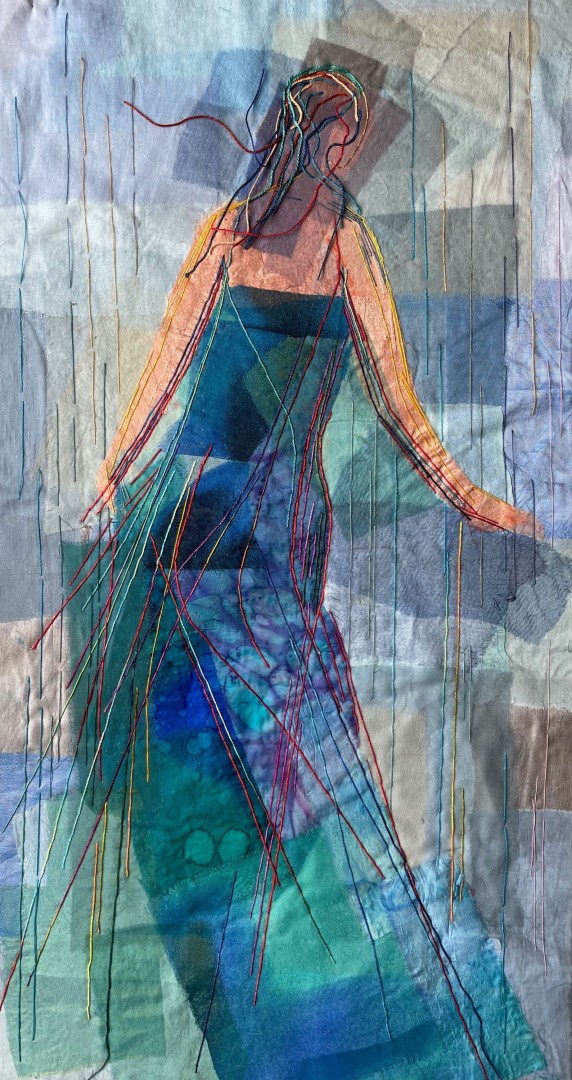Oxford artist colourist Prinkie Roberts is known for her original and intriguing stitched textile art, a world apart from traditional embroidery and homewares.
 Although textile is still a minority discipline within fine art, Prinkie studied with Julia Caprara; an icon in the world of textiles and a master of colour who encouraged her students to forge their own paths and stretch their individual creativity. She also campaigned to elevate textiles so that it be recognised as an art form rather than a traditional craft worked by women, a hope that Prinkie, too, is passionate about.
Although textile is still a minority discipline within fine art, Prinkie studied with Julia Caprara; an icon in the world of textiles and a master of colour who encouraged her students to forge their own paths and stretch their individual creativity. She also campaigned to elevate textiles so that it be recognised as an art form rather than a traditional craft worked by women, a hope that Prinkie, too, is passionate about.
Prinkie’s pieces – both figurative and landscapes - appear to be almost painted with thin layers of colour, using a palette of torn strips of silk and fabrics rather than oils or acrylics. They’re then built upon with hand-stitching helping form shape and meaning. “Textiles can be used incredibly creatively,” says Prinkie. “We’ve probably all heard of the extraordinary way patchwork quilts have been used for storytelling in America when this was one of the most significant forms of creative expression available to American women in the 1800s, during the Civil War era. However, textiles can be used in many very different ways. There’s some gallery recognition for this now but there is still a way to go.
She continues, “Using textiles can be surprisingly similar to sculpture, in that they’re both very tactile and you are working with your hands. However, sculpting was about clay, form and casting rather than colour. Once I had gravitated to the colours of textiles I couldn’t go back. Now it has become second nature to me, and is key to my work.”
To a background of calico, Prinkie adds torn strips of thin fabric in many layers, bonding them together before, towards the end of the process, adding big and bold stitches by hand to either emphasise a shape or alternatively, to blur its edges. And although Prinkie’s smaller works are mounted, her larger pieces of wall art are gently irregular in shape; softened and without straight lines and sharp edges. Loose threads may deliberately hang freely down, adding a feeling of the free-spirited nature that working with fabric allows.
Always opting for strong colours, Prinkie mostly chooses diaphanous fabric from Indian scarves and saris, often recycling previously-used garments. “Part of the joy of working with textiles is sourcing the fabrics,” she adds. “As well as plain pieces, I use gently patterned fabric to add texture and depth of tone. The thinner the fabric, the better,” she explains, “as there are then echoes and shadows of layers beneath in the finished piece.”
With flowing lines, and a loose intuitive style, Prinkie ’paints’ with layered fabric and a needle, the contours of the thread and the position of the stitching hints at or defines shapes within the picture. They can form lines or add areas of shading as you might when drawing with a pencil. The strong thread, usually cotton, is as integral to the piece as the fabric and, created in this raw visceral way, Prinkie’s pieces need to no additional embellishment. “I have a huge range of thread in different thicknesses and a million colours,” she smiles. “It appeals to the hoarding instinct in me”.
 Some of Prinkie’s most recent pieces – for this year’s Oxfordshire Artweeks, for example - are inspired by Strictly Come Dancing and the winner of the 2022 series, British wildlife cameraman and presenter from CBeebies and Countryfile, Hamza Yassin. “I’d never watched Strictly before, but my daughter had mat Hamza, a wonderful charismatic and gentle man whilst cycling in Scotland. We wanted to follow his progress in the series – it seemed like he might be the underdog. How wrong you can be?”
Some of Prinkie’s most recent pieces – for this year’s Oxfordshire Artweeks, for example - are inspired by Strictly Come Dancing and the winner of the 2022 series, British wildlife cameraman and presenter from CBeebies and Countryfile, Hamza Yassin. “I’d never watched Strictly before, but my daughter had mat Hamza, a wonderful charismatic and gentle man whilst cycling in Scotland. We wanted to follow his progress in the series – it seemed like he might be the underdog. How wrong you can be?”
These pictures sizzle with hot strident colours: oranges, pinks and reds with gold thread evoking the glamour and panache of the programme. In this flamboyant palette, with layers and stitching, Prinkie portrays a feeling of movement, and an essence of the dance. Drawing on her experience of life drawing and sculpting the human figure, her pieces suggest the form of the dancers adding and room for the viewer to use their own imagination.
“I’m also inspired by landscapes”, she says, “by being in the countryside and in new places, the way it affects me and the feeling I have in those spaces.” These landscapes are not literal; rather they’re a starting point for abstraction. “Textiles seem to lend themselves to abstraction. That’s part of their beauty: textiles give you great freedom. They aren’t at all prescriptive like many other media that artists work with”.
Her landscapes of the mountainous areas of Scotland and Wales shimmer with vivid greens and blues and turquoise. Intriguingly, constructed intuitively from multiple layers of shape and colour, the final interpretation of Prinkie’s textile work can vary, with certain pieces conjuring a seascape through the eyes of some viewers whilst others relate more to the cliffs and rolling countryside.
For further information visit prinkieroberts-textile.art








